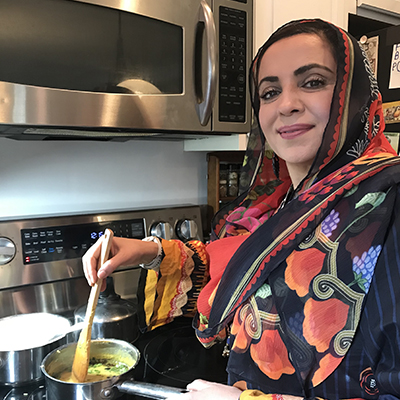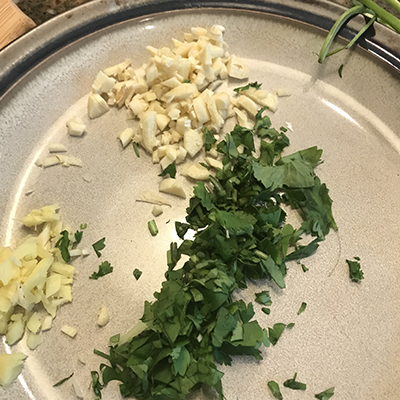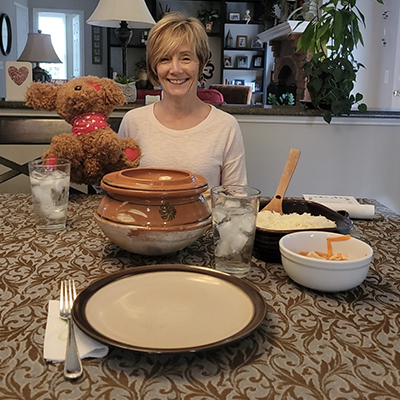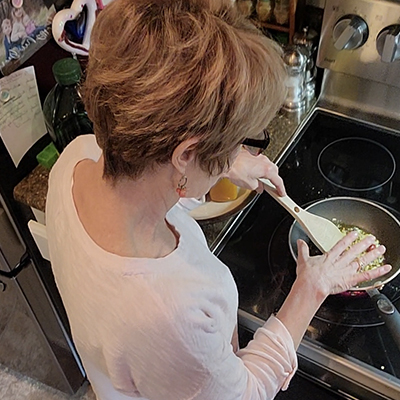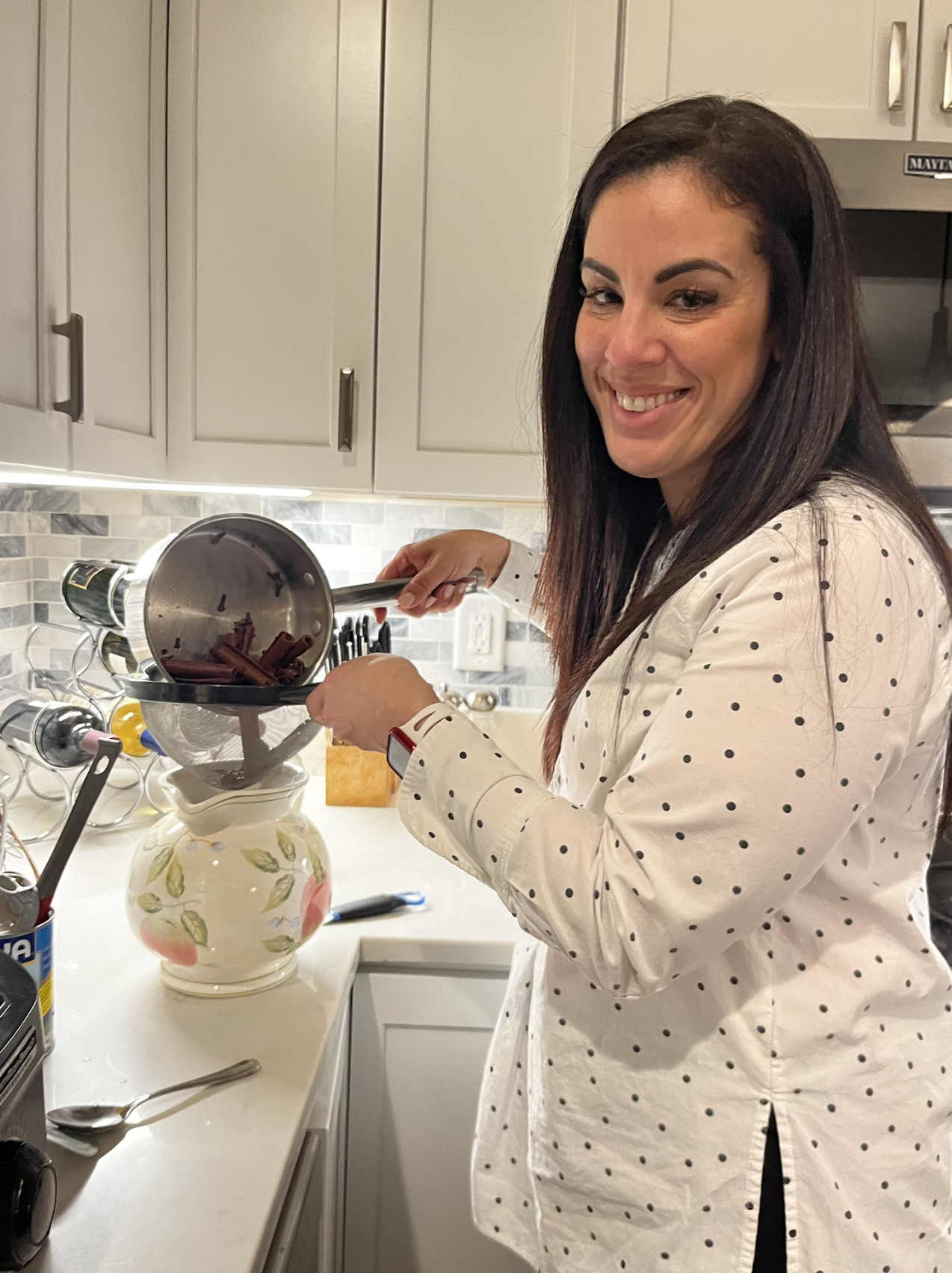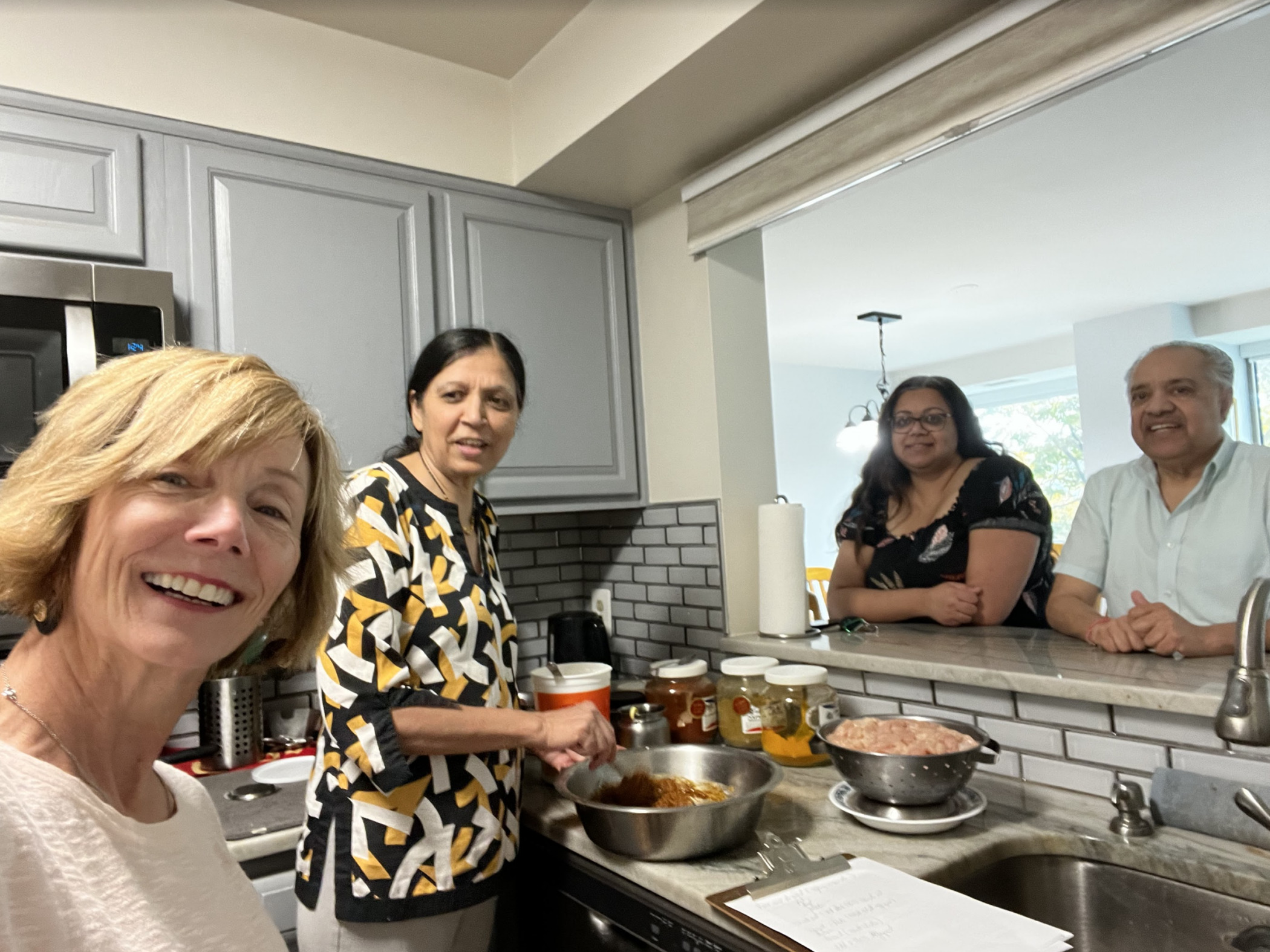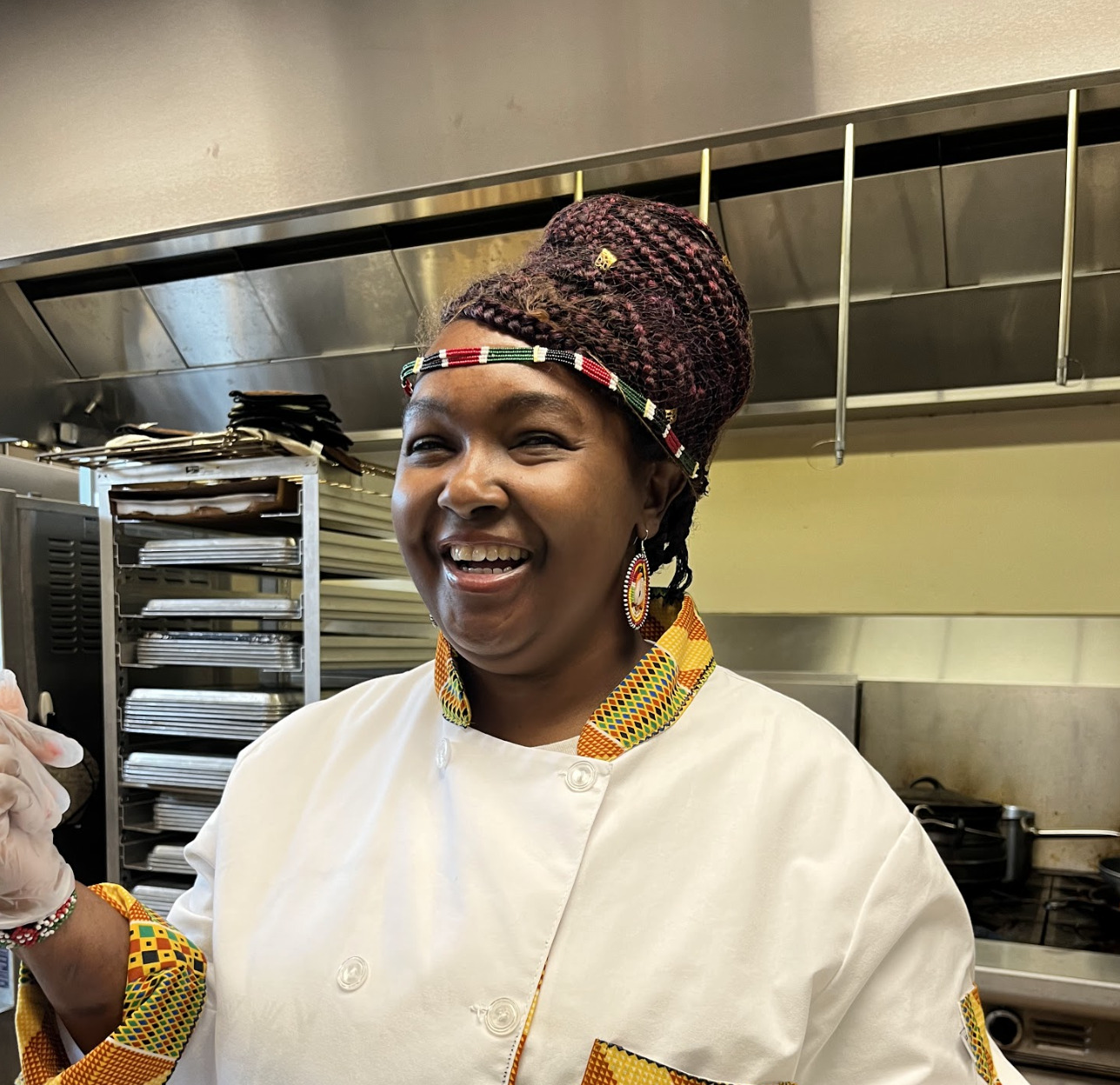Short and sweet…that’s the best way to describe the last edition of “A Yummy Year:…

February – Anila Haq
On the Friday following Valentine’s Day, the doorbell rang right at 11 a.m., just as expected. Standing there on the welcome mat was a most-welcome visitor…Anila Haq, Prime Time for Women’s “cultural chef” for February. She had her arms full, holding a plastic bin containing traditional Pakistani cooking ingredients, a beautiful clay pot and a gift for me, an adorable stuffed dog sporting a Valentine’s Day-inspired, heart-covered red bandana! After lugging everything into the house and setting it on the counter, I finally got to embrace Anila, welcome her to my home and properly thank her for my new toy (which I’m quite sure my five grandkids will be fighting over the next time they come to visit.)
Anila, whose enthusiasm meter is always on high, was super excited to be cooking with me as part of Prime Time for Women’s monthly cooking adventure and food blog, “Cultures, Cooking & Connections.” She was looking forward to teaching me how to prepare a traditional Pakistani meal, while sharing treasured memories of her homeland and her family.
“So what are we making today?” I asked. Pulling from her bin basmati rice, red lentils, fresh ginger, garlic, onion, cilantro, roasted red pepper flakes, cumin seeds, turmeric, pink sea salt and cayenne pepper Anila replied, “We are going to cook Daal and Chawal, a traditional meal of rice and red lentils, which can be adapted for every palate.” Now that’s perfect for me because I’m a creative cook. I come from a large family known for creative interpretations of directions. In fact, my husband teases me saying, “I know you are a Howard, but not everything is a suggestion. Sometimes you really do have to follow instructions.” Okay, I guess I agree with him when it comes to obeying traffic signs and filing taxes…but definitely NOT when it comes to cooking!
Doing a little research, I learned most of Pakistani cuisine has roots in the eastern provinces of Punjab and parts of Sindh and is characterized as highly seasoned and spicy. But Anila said the amount of seasoning reflects the whims of the chef and the preferences of those who will eat the food. As Anila minced the garlic and ginger and chopped the onion and cilantro, she instructed me to wash and then drain the rice and lentils. Next, she put the lentils and rice into separate pots, covered them with water and turned on the burner. When I asked her how many cups of lentils and rice to how much water she said, “As much as required. I don’t measure either ingredient…I ‘free-style’ it! When you cook lentils and rice as often as I do, you just go with the flow.” A woman after my own heart!
Next, Anila heated olive oil (about 1/3 cup) to which she added the garlic, ginger, cumin seeds, red pepper flakes and sea salt, and sauteed them until fragrant. The combination of herbs and spices sautéing in the hot oil made my mouth water! Anila instructed me to fold the herbs and spices into the daal (lentils) as she added turmeric, cayenne pepper and salt. Watching her made me curious about where she learned to cook, so naturally, I asked. Anila explained, as a young girl in Pakistan, she was a tomboy and preferred to be outside competing with her three brothers than inside cooking. Though she didn’t prepare a lot of meals with her mother she loved to make snacks such as cookies and fried samosa. That’s not surprising in the least. It seems to me, regardless of country of origin, most kids like to cook, and they all want to make sweet treats! In fact, when my grandkids come to visit one of the first things they ask is, “Yaya, what yummy treat are we going to make today?”
Anila is one of those efficient cooks. As the daal and chawal simmered on the stove, she jumped right in and started washing dishes and wiping down the counters so that by the time our food was ready the kitchen was immaculate! As we cleaned, Anila shared her immigration story. I found myself marveling at her courage, tenacity, and sense of adventure as she spoke of her arranged marriage, which required her, as a young woman, completely unfamiliar with the language and its customs, to move to the United States. Anila not only had to learn a new language, but she also had to create a new life with a man she barely knew. Together, they grew in love, supported one another, navigated the ups and downs of all marriage relationships, and raised a family of four children, who are now, along with their parents, sharing their skills and talents to make our country stronger.
From time to time as we prepped, cooked, and cleaned, Anila, who is a Muslim influencer, shared the experience with her followers, explaining in Urdu that by cooking together we hoped to celebrate the commonalities and uniqueness of different cultures. Of course, I joined in…waving and smiling to the camera. Though I didn’t understand a single word of Urdu, I felt seen and heard, like I was hanging out with friends!
Finally, and not a minute too soon, the daal and chawal were ready. As I had been smelling the delicious aromas for close to an hour, I couldn’t wait to eat! Anila carried the daal to the table in a traditional, hand-painted clay pot called a handi. The presentation was beautiful. Sitting at the table, we discussed pre-meal traditions practiced by our families. While I grew up in a Catholic family where grace was said at the start of each meal, Anila explained a similar practice in the Muslim tradition. Each meal begins with the phrase, “Bismaillah” which means “I start with the name of Allah” and ends with the phrase “Alhamdulillah” which translates to “Thank God.” We said these words together before eating. The Arabic words, though difficult for me to pronounce, felt familiar and comforting. I liked knowing that despite growing up on opposite sides of the world, with different religious traditions, we shared a life-long practice of gratitude. Taking in the bounty spread before us, I felt grateful for the food we were about to eat but even more, I felt a deep appreciation for our friendships and our shared humanity.
We ate and we talked. We talked and we ate! I learned that Anila has three brothers and one sister, living on three continents. As a child and the oldest daughter, Anila was very close to her Dad, who worked long hours as an accountant. Due to the demands of his career, he often missed dinner. However, on Fridays he always came home early and together the family would attend Jummah, the afternoon prayer service. Every Sunday, which was Anila’s favorite day of the week, her Dad cooked lunch and the family would picnic by a lake or at the park or outside surrounded by the flowers in their garden.
It’s funny that I also remember Sundays as a special time with my Dad. I attended a St. Lawrence Catholic School until fourth grade, and we were required to attend a special children’s mass each Sunday. My mom would take my sisters (Kathy, Jeanie, Patty and Barbie) and me to mass and my Dad would stay home with Rainy, Ginger, and Chris. I don’t know how he did it, with the little ones under foot, but every week when we would return from church, he would have a hot breakfast feast ready for us…sunny side up eggs, bacon, scrapple, orange juice and toast! Years later, after both my parents passed, all nine of the Howard siblings gathered to divvy up their possessions. The only thing I remember there being a disagreement about was who would get the black cast iron skillet that Dad used to make “Daddy Howard’s Special Breakfasts.” Don’t worry…I got it!
Anila’s father is still alive, and last year she returned to Pakistan to care for him when he was ill with COVID. For Anila, the visit was bittersweet. She was glad to care for her father and nurse him back to health, but it was evident that his dementia had progressed since she had last seen him. Luckily, he still recognized her and Anila enjoyed the many hours she spent with her mother and father. While in Pakistan, Anila took her parents to visit the cities where they grew up. As she shared this part of the story, she gave me a mini geography lesson on the different provinces of Pakistan, which I now know are Punjab, Sindh, Baluchistan and Khyber Pakhtunkhwa. I probably should have learned this is World History Class during junior year of high school but, and this may be a shock to some of you, I was busy talking!
Finishing up the meal I said, “That was delicious! I can’t wait to try other traditional Pakistani dishes.” That’s when Anila said, “Save the date of July 3rd. “My daughter Maheen, who knows traditional cooking, is getting married that day and you can celebrate with us!” She explained in detail the traditional menu they are planning to serve at the reception, including punjabi, pakora, samosas and kulfi. All these dishes are delicious, but they are much more than that. For Anila and her daughter, they are emotional touch stones, expressions of their heritage and a celebration of their culture. For me, ethnic dishes serve as windows into other cultures, a chance to expand my taste buds and my limited understanding of our vast, wide world. During our delicious meal, Anila and I shared childhood memories, discussed religion, and reminisced about our fathers, but we also expanded our perspectives and grew in appreciation for each other’s journey. It’s true…food nourishes the body but sharing it with others nourishes the soul!


